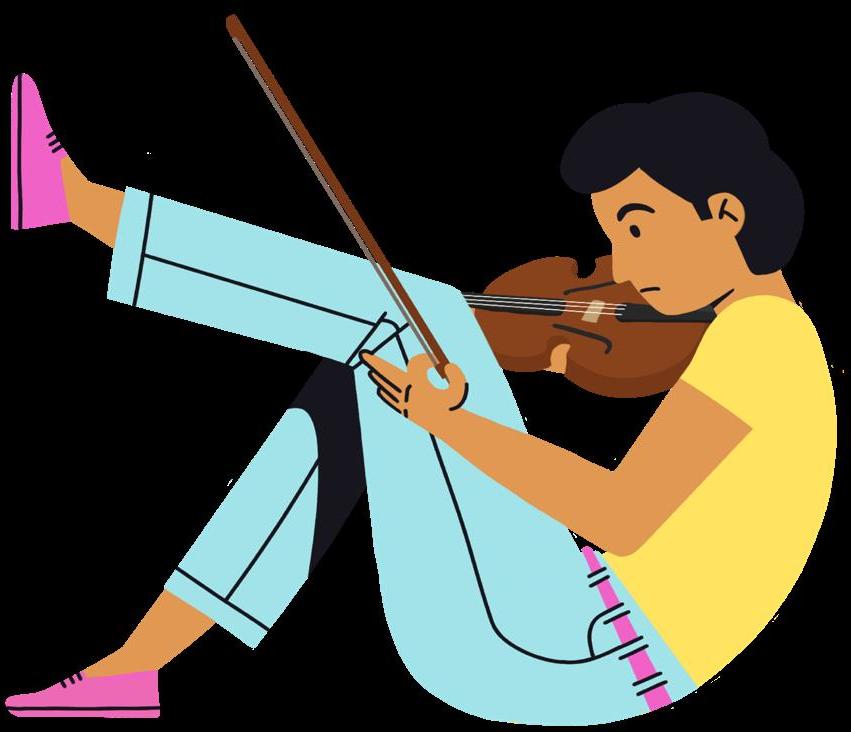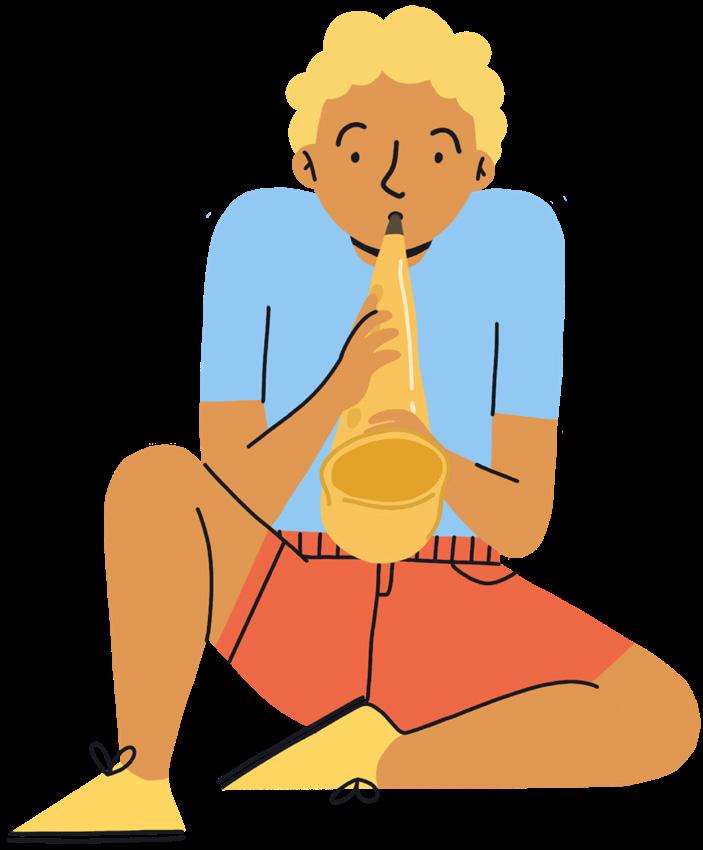
6 minute read
Adapting the arts
ADAPTING
CLASSES FIND NEW WAYS TO CREATE
THIRTY STUDENTS’ FACES completed masterpiece comes into view. pop up on a black screen, each This year, visual art classes mostly operate in their respective rooms with the same way, only with a more hands-off an instrument in hand. After a approach. Students generally check into moment filled with the plucking of strings Zoom for attendance and then sign off to to find starting notes, and the sound of air work on their projects, whether it be on conditioners and passing cars, the angel- kitchen tables, converted desks or outdoor ic “Somewhere Over the Rainbow” floats work stations. Compare this with the colthrough the speakers. This is Palo Alto orful crowd that once filled the art rooms, High School’s “Spring ‘Virtual’ Concert and it’s definitely a different atmosphere. and Senior Celebration 2020,” and perhaps Junior April Wu, who is currently takwhat most performances will look like in ing AP Studio Art 2D Design, misses the the school year. frequent progress check-ins with her teach-
Across all departments, COVID-19 er but finds that the new format has providand the resulting campus closure have ed her with other opportunities. caused extreme shifts in the student experience. However, few classes have been hit as hard as the Visual and Perform“It’s kind of nice having freedom in a way, because then I can kind “It’s kind of nice having freedom in a way, because then I can kind of do things my own way and see where I would go without ing Arts programs. of do things my own supervision,” Wu said. Classes like theater, band and sculpture way and see where I “It’s more of an exploration kind of thing.” rely on a close sense would go without su- Subjects such as of community, along with materials and pervision.” ceramics, painting and glassblowing heavily equipment provided — APRIL WU, junior rely on physical maby Paly. Despite these terials and tools, as difficulties, VAPA well as an appropriate teachers and students are determined to workspace. Yet with supply cabinets locked make this year valuable. up and classrooms collecting dust, teachers
“We just made a decision this year that and students are searching for creative al[no matter what], no way we were not go- ternatives. ing to teach,” said Kate McKenzie, the Ad- Take, for example, Paly’s celebrated vanced Painting & Drawing and AP Studio glassblowing program, which has been disArt 2D Drawing & Design teacher. continued while students remain at home. To carry on their craft, according to senior The visual arts vision Andrew Guillet, some glassblowers go to
The whisk of a brush. A finishing Public Glass, a glassblowing studio in San touch. Stepping away from the canvas, the Francisco. However, the commute and restrictive time slots make the process inconvenient and less enjoyable.
Despite these immediate challenges that come with online learning, some unexpected and interesting changes have surfaced. To McKenzie, recent student work has gained a new depth due to newfound struggles and stories.
“The work that I saw coming in was so emotional and so strong,” McKenzie said. “That does come out in really powerful ways in art that I don’t get in the classroom.”
Straying from the stage
A final sob. Thunderous applause. With a bow, the curtains close on another successful show. Students, staff and families have long enjoyed numerous onstage performances, ranging from the serious “Tartuffe” to the silly “The 25th Annual Putnam County Spelling Bee.” Due to distance learning, however, Paly’s plays and theater classes have changed dramatically.
Theater students are currently focusing on voice work, which includes creating character voices, dialects and accents — skills that can be easily developed over Zoom. It’s also less challenging to learn about history and playwriting when computers — which usually aren’t available in theater rooms — are guaranteed in front of every student, according to Sarah Thermond, the Theater and Stage Technologies and Design teacher.
However, as senior Kristen Liu puts it, theater is an art that relies on physical interaction, so the in-person experience is almost impossible to emulate.
“It’s so weird because we’re not standing up and seeing each other, we’re just sit-
THE ARTS
Text by MIA BALDONADO and
ZANDER LEONG
Art by SAMANTHA HO

ting and reading the script,” Liu said. “You just don’t get the full effect.”
Although this aspect of theater is diminished, Thermond is working to maintain the sense of community that guides the performing arts.
“I like doing a lot of warm up activities and improv exercises because those tend to generate laughter,” Thermond said. “I think once you’ve been in a class where you’ve laughed with your peers and they’ve laughed with you, you tend to feel closer to them.”
Always vital to the theater process, Stage Technologies and Design students coordinate key elements such as lighting, sound, backdrops and props to create settings for each show. Now, rather than managing this separately, the students will work with actors to transform their homes — a task that has new opportunities with Zoom.
“In a way I get to experience more jobs, I get to see more things because it’s

very easy to tune in to something now,” ju- thing to hear it as you’re doing it and to nior Olivia Gee said. “You don’t have to be be able to adjust and feel the music,” sethere physically, so if you want to be at a nior and choir student Ben Norton said. “I rehearsal you can just pop in.” think it really does make a difference in the
No matter the direction they take, the- musical decisions you make and the final ater is bound to be new and exciting with product.” the upcoming virtual “Mystery, Murder, & Across the district, teachers are finding Monsters” show, which includes three per- ways to encourage more involvement; stuformances from Nov. 6–13. dents are learning to use apps to create their own music videos, and in choir, students Music moves to media have the options to learn about vocal health
Bows fly off strings. The audience holds and the history of vocal music. its breath. As the conductor signals the last Jeffrey Willner, the Instrumental Munote, resolving harmonies ring through the sic teacher, has explored technology more hall. Like theater, the band, orchestra and due to the shift to online learning. In parchoir programs cannot have their regular ticular, he plans on using Smart Music — stage performances. Unfortunately, Zoom software that aids in creating and evaluating performances aren’t a viable option for them either due to audio lag, as musicians cannot play in time with each other. Music ensembles “It’s going to be crazy. It’s going to be weird. And we’re going to students’ recordings — even when classes transition back to in-person. “I’m a boomer, big time, you know,” and technology usually don’t mesh well, achave to adapt.” Willner said. “And so it’s forced a lot of cording to senior and — JONATHAN SNEH, senior us older people way orchestra student Noah into using this tech Holbrook. more than we did
“You have like 50 students and they [before].” all have to get on to these new platforms,” As music students learn to apply techHolbrook said. “Invariably you know, nology, visual arts classes look for workthrough no fault of their own, someone’s spaces and materials while theater prepares tech won’t cooperate.” to perform online. The arts may be drasti-
When the only functional way to cally different and may not live up to the make music is with click-tracks — audio classes they were before, but for now, stuused to synchronize players — and piecing dents and teachers will have to get creative together individual recordings, students in finding ways to create. miss out on the feeling of playing together “We don’t know exactly how things in an ensemble. are gonna go,” senior Jonathan Sneh said.
“It’s one thing to hear a bunch of re- “It’s going to be crazy. It’s going to be weird. cordings all put together, and it’s another And we’re going to have to adapt.” v










